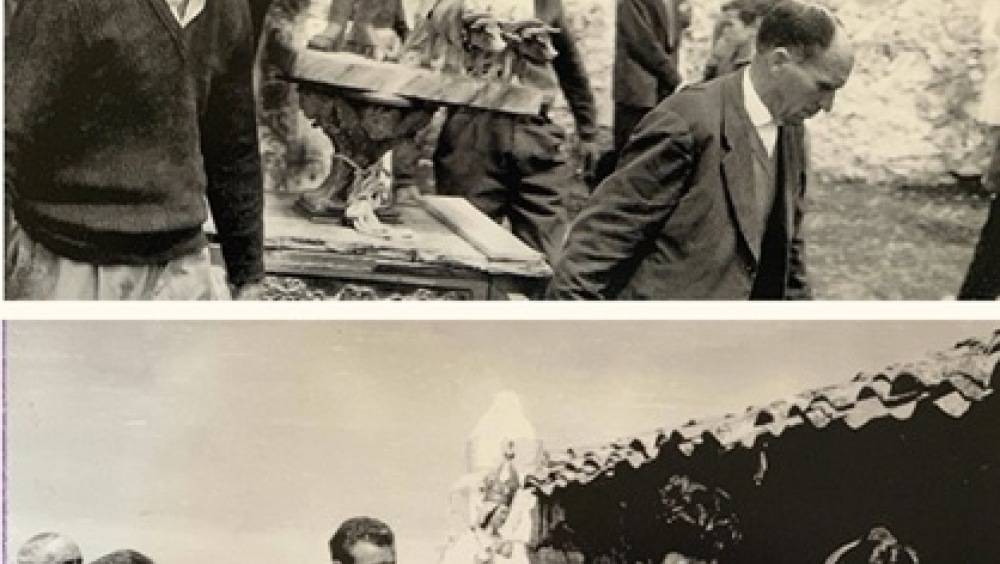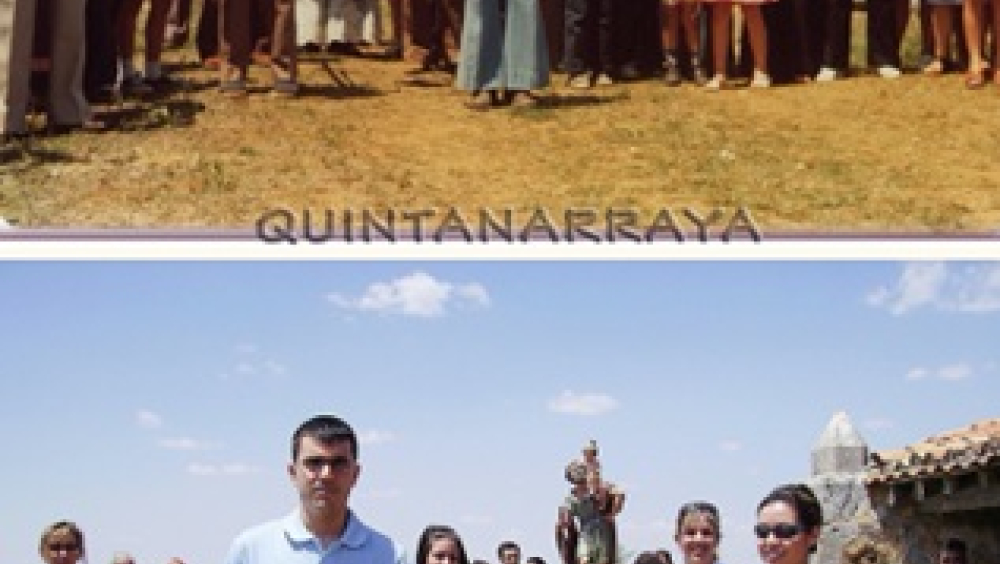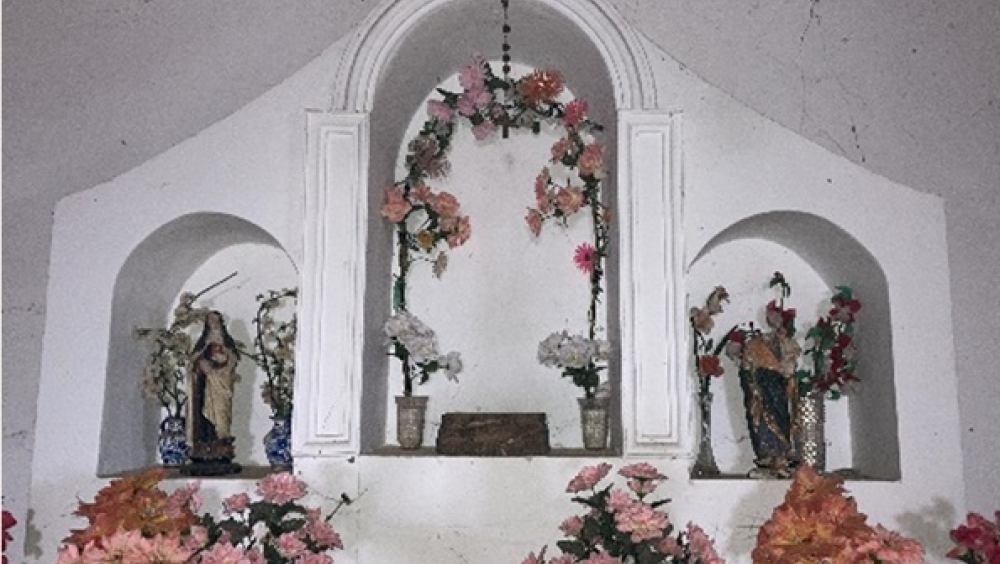Ermita de Santa María la Antigua - Hermitage of Santa Maria la Antigua
Quintanarraya is currently a village of just over a hundred inhabitants. Those who know how to observe remain silent with rage and helplessness as they observe and interpret the architectural and historical heritage of what once was, and which, not only because of the passage of time but also due to the lack of interest of the authorities, is being lost.
This is the case of our beloved hermitage of Our Lady of the Ancient, patron saint of our town.
In the 16th century, the Avellaneda family and the Canon of Seville began its construction simultaneously with the Hermitage of the Virgin of Castro in Peñalba de Castro. It is located on the so-called Senda de los Frailes (Send of the Friars), which ran from the Convent of the Jerónimos Friars of Guijosa (Soria Province) to Peñalba de Castro, serving as a place of prayer. Other historical theories suggest that the Hermitage is located on the Roman Road that ran between the Roman cities of Clunia, Arganza, and Numantia, postulating that a Roman cemetery existed nearby.
Today, with the passage of centuries, the hermitage needs help. In addition to the history it hides, it has currently been closed to the public for more than ten years as a precaution.
However, two pilgrimages are held outside every year to preserve the identity and traditions of its people.
At the recent European Heritage Days in 2024, we spread the word, according to the JEP motto, that we have diverse paths, trodden by centuries of travelers, soldiers, and merchants, shaken by the iron of cavalry and the tread of farmers, making it a pan-European and universal theme. Those who pass through Quintanarraya are filled with memories that the guests at those outreach talks discovered.
This year, through the JEP 2025, we want to highlight the architecture we have inherited, perhaps not as monumental, but key to building the identity and legacy of the customs and traditions of a small, great people.
Quintanarraya boasts a Celtiberian "Klounioq" (Arevacan) site, yet to be discovered. A carbon-14 analysis revealed that it dates back at least to the 4th century BC, which would later give its name to the neighboring Roman city of Clunia. Perhaps this is why Quintanarraya has five windmills (four of which remain, and one is still working) installed in series, and next to one of them is our beloved Roman bridge: "El Puente Canto." This will be part of the European Heritage Days in 2025.
The Church of San Pedro Ex-Cathedral and the Hermitage of San Roque are also legacies of our history. But what concerns us now is our beloved Hermitage of Santa María la Antigua.
Giving a little history, and to demonstrate the historic-artistic character of the Hermitage, it is noted that it dates back to the 16th century. It was commissioned by the Avellaneda family (Peñaranda de Duero) and by Francisco de Santillana (Canon of Seville), who resided in Quintanarraya at that time. Its construction was carried out simultaneously with the Hermitage of the Virgin of Castro in Peñalba de Castro and is located on the so-called Senda de los Frailes (Send of the Friars), which ran from the Convent of the Jerónimos Friars of Guijosa (Soria Province) to Peñalba de Castro, serving as a place of prayer. Other historical theories suggest that the Hermitage is located on the Roman Road that ran between the Roman cities of Clunia, Arganza, and Numancia, postulating that a Roman cemetery existed nearby. This altar dates from the same period of construction as the Hermitage (16th century).
In the side niches, we find the images of Saint Teresa and Saint Christopher with the Child (the latter in poor condition, with its head separated from its body), both made of polychrome plaster. In addition, there are two ceramic vessels with a white background and blue plant motifs.
The most valuable figures, as they are the town's patron saints, such as the Virgin of the Antigua, Saint Christopher, and Saint Isidore, are now preserved in the Church of San Pedro de Antioquia, the town church, due to the deterioration of the temple. On the left side of the altar, three biblical texts in Latin are framed, with images of the crucifixion, the apostle Saint John accompanied by an eagle, and Christ depicted as a king playing the lyre, dating from the Romanesque period of the 11th century. In another frame, there is a drawing of Saint Lucy on an altar in the early Gothic style typical of the mid-12th century. In addition, there is a Renaissance-influenced work from the Cinquecento (16th century) whose theme is the Descent from the Cross.
To the right of the entrance, on a pedestal, stands the Romanesque baptismal font, dating from the 11th to 12th centuries. It is circular in shape and decorated with simple collars, two on the inside and one on the top, on which the font is placed.
Three special celebrations and three or four smaller ones are held at the Hermitage throughout the year. The three main ones coincide with San Cristóbal, San Isidro, and Nuestra Señora de la Antigua, with a gathering of all attendees with a communal meal in the mountains surrounding the Hermitage. During these celebrations, the fields are blessed on the day of San Isidro, and the vehicles on the day of San Cristóbal. These festivities have been held for countless years and are a very important part of Quintanarraya's history, much loved and respected by its residents and visitors. People from all over the region and from different parts of Spain attend them, contributing greatly to the life of the town and to the maintenance of its traditions and culture. As a general conclusion, and considering this is an area with a lot of life despite being in rural Spain, this opportunity is seen as a way to support both our great Burgos heritage in the villages, as well as the love and culture of its people, which make it possible for places like the Hermitage of Our Lady of the Ancient in Quintanarraya to continue to have great importance and relevance today.
Quintanarraya highlights its rich natural, historical, archaeological, and intangible heritage within the framework of the European Heritage Days (EHD). These days are a joint program of the Council of Europe and the European Union, and the national coordination of the events falls to the Spanish Cultural Heritage Institute (IPCE).
For this reason, the Quintanarraya Town Council is organizing various events this year, in 2025, in collaboration with the town's cultural associations: Friends of Klounioq, La Espiga, and the AstroDemanda Astronomical Association.


